Local Headset Network
-
- Now Hear This: Maritime Hearing Protection Marine News, Oct 2013 #40
Better communication and hearing protection in the maritime environment through wireless headsets.
Clear communication is essential for a safe, effective and productive workplace. Too often, however, excessive levels of background noise make communication difficult. An estimated 22 million Americans are exposed to hazardous levels of workplace noise each year — four million are exposed every day. If you work in the maritime environment, you are likely among those four million. It has long been known that marine vessels are noisy places, and studies have demonstrated a clear correlation between long-term assignment aboard Navy ships and an increased rate of hearing loss.
Too Much Noise
Prolonged exposure to excessive noise leads to a condition known as “noise-induced hearing loss” (NIHL), the most common work-related illness in the United States. NIHL is hard to detect because it develops, in Coast Guard terminology, by the “three Ps”: painlessly, progressively and permanently. Once hearing has been lost, there is no way to reverse the damage.
Excessive noise has been linked to other ill effects, including tinnitus (ringing in the ears), high blood pressure, headaches, muscle tension, ulcers and poor job performance. Maritime studies have linked constant noise exposure to aggressive behavior and sleep disturbances. High noise levels aboard ship also interfere with the audibility of speech and warning signals, both of which impair safety. Noisy work environments pose an even bigger problem: how to protect workers from NIHL while simultaneously enabling them to talk with each other on the job. Earmuffs may guard against hearing loss, but make it even harder for workers to hear each other. Walkie-talkies enable direct communication but do nothing to protect hearing and also require a free hand for operation. Hand signals require line-of-sight visibility and can be misinterpreted.
Studies have shown that 80 percent of maritime accidents are due to human error, not equipment failure. Safety specialist Gordon Dupont has noted that one of the most common human errors is “lack of communication.” If workers cannot exchange information, the stage is rigged for an accident. Excessive noise greatly interferes with that exchange.
How Loud are Workboats?
The “excessiveness” of noise exposure depends on the intensity of the noise as measured in decibels (dB) and the length of the exposure. OSHA requires workers to wear hearing protection when exposed to an average of 85 dB over an eight-hour period, the threshold at which hearing damage begins to occur. The American Bureau of Shipping and the International Maritime Organization have issued similar guidelines.
How does the 85 dB “threshold” translate into the maritime environment? The short answer is that noise is a significant stressor on board ships. Crew quarters are often in close proximity to the propulsion mechanism, which creates issues with both noise and vibration. Studies have recorded noise levels as high as 120 dB in the engine room and ventilation system, which exceeds the human pain threshold. Other data show that 55-60 meter trawlers generate average noise levels of 85 dB over a 14-day trip. By comparison, a ticking watch emits 20 dB; normal conversation, 50 dB; a motorcycle, 100 dB; and a jet takeoff from 75 feet away, 150 dB. Sounds over 150 dB will rupture the eardrum. The decibel scale is logarithmic, so sound exposure escalates quickly. Every increase of 3 dB cuts the allowable exposure time in half, and each increase of 10 dB doubles the perceived intensity of sound. Using OSHA’s limit of 85 dB per eight-hour day as a benchmark, exposure to 100 dB of noise for more than 15 minutes would trigger the need for hearing protection.
Wireless Communication Headsets: Mobility and Situational Awareness in One
While hearing protection and clear communication might seem to be at odds, wireless communication headsets are an excellent way to bridge the gap (Figure 1). Wireless headsets can reduce background noise by 20 decibels or more and allow all crew members to communicate clearly. Headsets fit over the ear for hearing protection and are outfitted with a boom microphone and ear speakers to allow hands-free voice transmission and reception through a mobile base station. In some systems, the local headset network can be connected to a land-based operator via a two-way radio.
The premise of a wireless headset system is simple: everyone can hear and be heard, and no one is exposed to potentially harmful levels of noise. This allows all crew members to maintain complete situational awareness: the ability to stay in constant contact on the water, talk in normal voices without shouting or gesturing and provide real-time verbal warnings in dangerous situations. Situational awareness also means greater productivity and efficiency. By removing the barriers to good communication, wireless headsets allow everyone to get more done in less time.
Wireless headset systems offer one other important benefit for maritime workers: mobility. Unlike hardwired systems, wireless systems avoid the need to “plug in” to a stationary audio jack. Workers can move freely about the boat without being tethered to a particular location. And because wireless headsets operate hands-free, there’s no need to hold a microphone or fumble with push-to-talk buttons. Communication is continuous, convenient and conversational.
Choosing a Wireless System
Wireless headset systems are available in a variety of configurations and price ranges. Before you purchase, make sure the wireless system is truly wireless. Some so-called “wireless” systems actually require a cord from the headset to a belt station, creating the danger of entanglement. Moreover, wires are usually the weakest part of any system due to corrosion and breakage.
Depending on the number of headsets you need to connect, wireless systems can run from several hundred dollars to several thousand dollars. Professional-grade systems may cost a bit more up front, but will save you money in the long run through better reliability, fewer repairs and greater longevity.
Overall, wireless headset systems simply provide a better, more productive and less stressful user experience. Shouting, waving and straining to hear over background noise is exhausting. By simultaneously removing the effects of harmful background noise and creating an environment in which normal conversation can take place, wireless headsets offer the best of both worlds: hearing protection and communication clarity. They could even save a life.
(As published in the October 2013 edition of Marine News - www.marinelink.com)
-
 )
March 2024 - Marine Technology Reporter page: 20
)
March 2024 - Marine Technology Reporter page: 202024 Editorial Calendar January/Februay 2024 February 2024 March/April 2024 Ad close Jan.31 Ad close March 21 Ad close Feb. 4 Underwater Vehicle Annual Offshore Energy Digital Edition ?2?VKRUH:LQG$)ORDWLQJ)XWXUH ?2FHDQRJUDSKLF?QVWUXPHQWDWLRQ 6HQVRUV ?6XEVHD'HIHQVH ?6XEVHD'HIHQVH7KH+XQWIRU ?0DQLS
-
 )
March 2024 - Marine Technology Reporter page: 4
)
March 2024 - Marine Technology Reporter page: 4MTR again brought in it’s professional video team, and with that we Manager, Marketing recorded nearly two dozen interviews across most ever geographic local and product/tech Mark O’Malley [email protected] sector you could imagine; interviews that will ? ll our Marine Technology TV feed on Accounting w
-
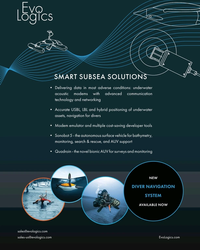 )
March 2024 - Marine Technology Reporter page: 2nd Cover
)
March 2024 - Marine Technology Reporter page: 2nd CoverSMART SUBSEA SOLUTIONS • Delivering data in most adverse conditions: underwater acoustic modems with advanced communication technology and networking • Accurate USBL, LBL and hybrid positioning of underwater assets, navigation for divers • Modem emulator and multiple cost-saving developer tools • Sonobot
-
 )
April 2024 - Maritime Reporter and Engineering News page: 39
)
April 2024 - Maritime Reporter and Engineering News page: 39Vessels (PSV) tender processes. Yara Clean Ammonia, Azane and Fjord Base will now commence work with their project partners to obtain a permit with the local municipality before a ? nal investment deci- sion. Image courtesy YCA www.marinelink.com 39 MR #4 (34-44).indd 39 4/5/2024 9:17:38 A
-
 )
April 2024 - Maritime Reporter and Engineering News page: 35
)
April 2024 - Maritime Reporter and Engineering News page: 35SIMULATION e have a close relationship with tech- Realism is prized beyond immersive, photo-realistic visu- nology, evidenced by, for example, als, and providers are introducing increasingly accurate func- the phones we are estimated to un- tionality. FORCE Technology’s upcoming DEN-Mark2 math- lock around
-
 )
April 2024 - Maritime Reporter and Engineering News page: 21
)
April 2024 - Maritime Reporter and Engineering News page: 21he sees a need for further sup- port – incentives and subsidies – to develop ports and proj- Roadblocks on the Wind Path ects. “We need to help educate the local communities, help- Like most organizations in the maritime and offshore sec- ing them [especially government representatives] to better tors, renewable
-
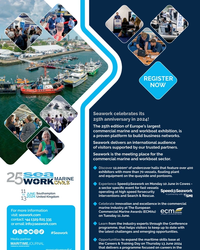 )
April 2024 - Maritime Reporter and Engineering News page: 7
)
April 2024 - Maritime Reporter and Engineering News page: 7REGISTER NOW Seawork celebrates its 25th anniversary in 2024! The 25th edition of Europe’s largest commercial marine and workboat exhibition, is a proven platform to build business networks. Seawork delivers an international audience of visitors supported by our trusted partners. Seawork is the
-
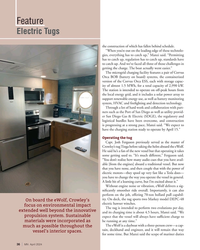 )
April 2024 - Marine News page: 36
)
April 2024 - Marine News page: 36Orca ESS, each with storage capac- ity of almost 1.5 MWh, for a total capacity of 2,990 kW. The station is intended to operate on off-peak hours from the local energy grid, and it includes a solar power array to support renewable energy use, as well as battery monitoring system, HVAC and ? re? ghting and
-
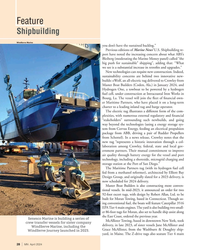 )
April 2024 - Marine News page: 28
)
April 2024 - Marine News page: 28Schottel). In a news release, Crowley notes that the new tug “represents a historic innovation through a col- laboration among Crowley, federal, state and local gov- ernment partners. Their mutual commitment to improve air quality through battery energy for the vessel and port technology, including a shoreside
-
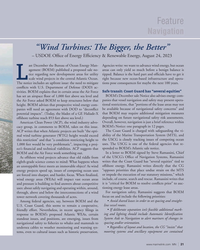 )
April 2024 - Marine News page: 21
)
April 2024 - Marine News page: 21Feature Navigation “Wind Turbines: The Bigger, the Better” – USDOE Of? ce of Energy Ef? ciency & Renewable Energy, August 24, 2023 ast December the Bureau of Ocean Energy Man- Agencies write: we want to advance wind energy, but ocean agement (BOEM) published a proposed sale no- areas can only yield so
-
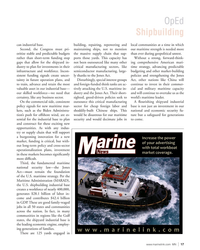 )
April 2024 - Marine News page: 17
)
April 2024 - Marine News page: 17OpEd Shipbuilding can industrial base. building, repairing, repowering and local communities at a time in which Second, the Congress must pri- maintaining ships, not to mention our maritime strength is needed more oritize stable and predictable budgets the massive supply chain that sup- than ever
-
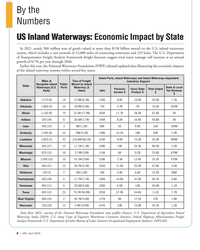 )
April 2024 - Marine News page: 8
)
April 2024 - Marine News page: 8of Freight Industries Support: Navigable Inland Public Moved by Inland State Waterways (U.S. Ports Waterway ($ Gross State Total Output State & Local Personal Rank) Value) Jobs Tax Revenue Income $ Product $ $ $ Alabama 1,270 (6)1927.8M (5.3B)134K8.4B15.9B35.4B1.7B Arkansas 1,860 (3)1018.9M (2
-
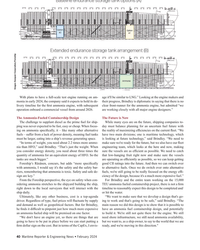 )
February 2024 - Maritime Reporter and Engineering News page: 40
)
February 2024 - Maritime Reporter and Engineering News page: 4015,000 sidering ammonia stretches to the shipyard building the ship, TEU ammonia fueled containership project, there is not a ? rm right down to the local surveyors that will interact with the timeline to reasonably expect this design to be completed and/ ship daily. or hit the water. Ultimately, like
-
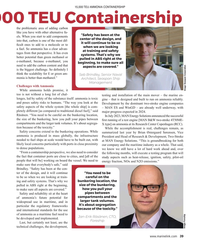 )
February 2024 - Maritime Reporter and Engineering News page: 39
)
February 2024 - Maritime Reporter and Engineering News page: 39Development, Two-Stroke needed to fuel ships at scale would have to be built out, with at MAN Energy Solutions. “This is groundbreaking for both likely local concerns particularly with ports in close proximity our company and the maritime industry as a whole. That said, to dense populations. we know we
-
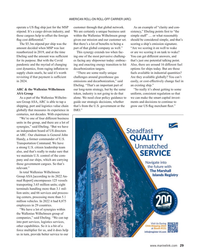 )
February 2024 - Maritime Reporter and Engineering News page: 29
)
February 2024 - Maritime Reporter and Engineering News page: 29AMERICAN ROLL-ON ROLL-OFF CARRIER (ARC) operate a US ? ag ship just for the MSP customer through that global network. As an example of “clarity and con- stipend. It’s a cargo driven industry, and We are certainly a unique business unit sistency,” Ebeling points ? rst to “the those cargoes help to
-
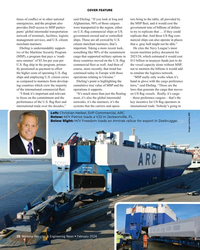 )
February 2024 - Maritime Reporter and Engineering News page: 28
)
February 2024 - Maritime Reporter and Engineering News page: 28COVER FEATURE times of con? ict or in other national said Ebeling. “If you look at Iraq and tors bring to the table, all provided by emergencies, and the program also Afghanistan, 98% of those cargoes the MSP ? eet, and it would cost the provides DoD access to MSP partici- were transported to the
-
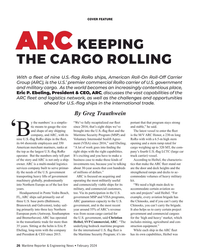 )
February 2024 - Maritime Reporter and Engineering News page: 26
)
February 2024 - Maritime Reporter and Engineering News page: 26COVER FEATURE ARC KEEPING THE CARGO ROLLING With a ? eet of nine U.S.-? ag RoRo ships, American Roll-On Roll-Off Carrier Group (ARC), is the U.S.’ premier commercial RoRo carrier of U.S. government and military cargo. As the world becomes an increasingly contentious place, Eric P. Ebeling, President
-
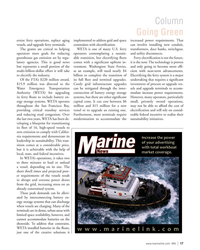 )
February 2024 - Marine News page: 17
)
February 2024 - Marine News page: 17requirements and demonstrate its leadership in sustainability. This tran- sition comes at a considerable price, but it is achievable with the help of local, state, and federal incentives. In WETA’s operations, it takes two to three minutes to load or unload a vessel, depending on its size. The short
-
 )
January 2024 - Marine Technology Reporter page: 3rd Cover
)
January 2024 - Marine Technology Reporter page: 3rd CoverSMART SUBSEA SOLUTIONS Delivering data in most adverse conditions: underwater acoustic modems with advanced communication technology and networking Accurate USBL and LBL positioning of underwater assets Modem emulator and other cost-saving developer tools Autonomous surface vehicle for bathymetry, monitoring
-
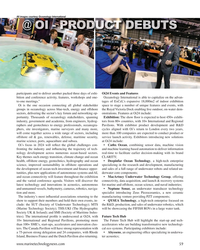 )
January 2024 - Marine Technology Reporter page: 59
)
January 2024 - Marine Technology Reporter page: 59All images courtesy Oceanology International participants and to deliver another packed three days of exhi- Oi24 Events and Features bition and conference activity, features, workshops and one- Oceanology International is able to capitalize on the advan- to-one meetings.” tages of ExCeL’s expansive 18
-
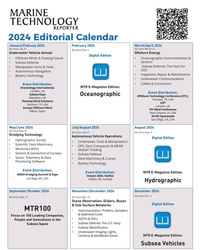 )
January 2024 - Marine Technology Reporter page: 53
)
January 2024 - Marine Technology Reporter page: 532024 Editorial Calendar January/Februay 2024 February 2024 March/April 2024 Ad close Jan.31 Ad close March 21 Ad close Feb. 4 Underwater Vehicle Annual Offshore Energy Digital Edition ?2?VKRUH:LQG$)ORDWLQJ)XWXUH ?2FHDQRJUDSKLF?QVWUXPHQWDWLRQ 6HQVRUV ?6XEVHD'HIHQVH ?6XEVHD'HIHQVH7KH+XQWIRU ?0DQLS
-
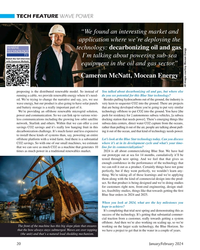 )
January 2024 - Marine Technology Reporter page: 20
)
January 2024 - Marine Technology Reporter page: 20TECH FEATURE WAVE POWER “We found an interesting market and application where we’re deploying the MARINE technology: decarbonizing oil and gas. TECHNOLOGY TV I’m talking about powering sub-sea Watch the full interview with Cameron McNatt: equipment in the oil and gas sector.” Cameron McNatt, Mocean
-
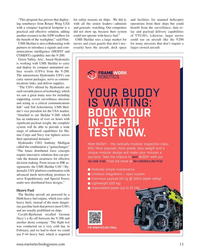 )
January 2024 - Marine Technology Reporter page: 13
)
January 2024 - Marine Technology Reporter page: 13“This program has proven that deploy- for safety reasons on ships. We did it, and facilities for manned helicopter ing sonobuoys from Rotary Wing UAS with all the senior leaders—admirals operations from their ships but could with a compact logistical footprint is a and generals--watching. Our competito
-
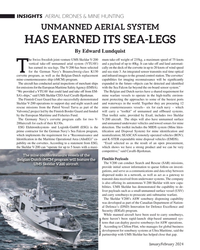 )
January 2024 - Marine Technology Reporter page: 12
)
January 2024 - Marine Technology Reporter page: 12INSIGHTS AERIAL DRONES & MINE HUNTING UNMANNED AERIAL SYSTEM HAS EARNED ITS SEA-LEGS By Edward Lundquist he Swiss-Swedish joint-venture UMS Skeldar V-200 mum take-off weight of 235kg, a maximum speed of 75 knots vertical take-off unmanned arial system (VTUAV) and a payload of up to 40kg. It can take
